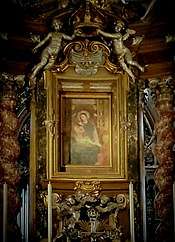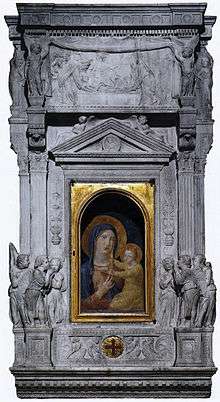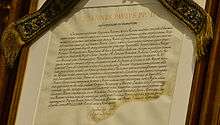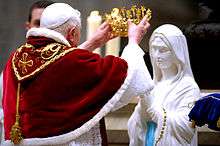Canonical coronation
A canonical coronation (Latin: coronatio canonica) is a symbolic ecclesiastical act of honour, a crowning, in the Roman Catholic church bestowed by the Pope or usually by his delegate, upon generally a Marian, Christological, or occasionally a Josephian image or statue which has conspicuously, and over an extended period, attracted the intercessionary devotion of the faithful in a particular place of worship.[1][2] It indicates a formal act of approval by the church authorities of public devotion to God, incited by a particular image in its specific setting and is duly expressed through the instrument of a Papal bull, a type of proclamation,[3][4] which is then generally carried out by a personal official of the Pope, a Papal legate, or on rare occasions by the Pontiff himself, by ceremonially attaching a crown, tiara, or stellar halo to the framework of the devotional image or statue.[5]
_(cropped).jpg)
Originally, the Holy Office issued the authorisation of a canonical coronation through a Church body, a dicastery, called the "Vatican Chapter". Subsequently until 1989, the Vatican's Sacred Congregation of Rites was assigned this duty. Since then, the Congregation for Divine Worship and the Discipline of the Sacraments arranges to execute the ceremonial act which the decree authorizes.
The canonical rite of coronation of a religious image is quite distinct from the annual ritual of May devotions to the Blessed Virgin Mary practiced in many Roman Catholic parishes involving the faithful, in particular children. In the latter case the crown is often a garland made of flowers and is of a transient if recurring nature.
History

The custom of crowning holy images, especially of Mary, Mother of Jesus, probably originated with the theological notions of the Desert Fathers in the Early Church epitomised in the queenship of Mary, as "Queen of Heaven" and later as "Stella Maris" among other epithets.[6] It has been depicted repeatedly in Western art through the centuries, especially before the arrival of universal literacy.[7] The formalised act of coronation of an image of veneration may be due in part to the initiative and practice of the Order of Friars Minor Capuchins, who on their evangelising missions collected great quantities of jewellery associated with the practice of indulgences, which funded at the request of the faithful, the gold crowns or accessories for images of the Virgin Mary, mainly in Italy. A particular Capuchin friar, Jeronimo Paolucci di Calboldi di Forli (1552-1620), was a major advocate for this practice, and was known during his life as a self-proclaimed "Apostle of the Blessed Lady." After a simple homily, Forli crowned the Nursing Madonna, now enshrined in the Sanctuary of Santa Maria della Steccata in the Italian city of Parma on 27 May 1601.[8]
Later, on 3 July 1636, the Marquis of Piacenza and Count of Borgonovo, Alessandro Sforza Cesarini died, having bequeathed in his will a large sum of money to the Vatican Chapter, for investment in the production of crowns of precious metals for the coronation of the most celebrated Marian images in the world. Funds from his bequest went towards the restoration of ‘’Madonna della Febbre’’ now enshrined in the sacristy of Saint Peter's Basilica in Rome.[9]
Development of the rite


The enactment of the rite of the coronation of a venerated image became widely popular in the Papal states prior to 1800, when approximately 300 coronation rites were performed. On 29 March 1897, an official rite was included in the Roman Pontifical, for which a plenary indulgence was also conceded to the faithful who participated in such rites.[10]
- The first Marian image to be ceremonially crowned without direct Papal approbation but performed by Cardinal Francesco Sforza Pallavicino was the Black Virgin of Oropa in Piedmont on 30 August 1620.
- The first Marian image that was Pontifically crowned was Lippo Memmi’s painting of La Madonna della Febbre (Madonna of Fever) in the sacristy of Saint Peter's Basilica in Rome on 27 May 1631, by Pope Urban VIII through the Vatican Chapter.
- The first Marian image crowned by a Pope himself instead of a proxy papal legate was the “Madonna Del Popolo” on 3 June 1782, by Pope Pius VI, at the Cesena Cathedral.
Enshrinement of the rite
The solemn rite of crowning images is contained in the "Ordo Coronandi Imaginem Beatae Mariae Virginis", published by the Holy Office on 25 May 1981. Prior to 1989, papal bulls authorising canonical coronations were inscribed manually on parchment. After 1989, the Congregation for Divine Worship and the Discipline of the Sacraments began issuing the authorisations, thereby authorising a Papal legate to perform the coronation of the approved devotional image on behalf of the Pope.
References
- "Mensaje con motivo del 50 aniversario de la coronación de la imagen de la Virgen del Camino (19 de octubre de 1980) - Juan Pablo II". w2.vatican.va.
- "Radiomensaje a los fieles mexicanos con ocasión del 50 aniversario de la coronación canónica de la Virgen de Guadalupe (12 de octubre de 1945) - PIUS XII". w2.vatican.va.
- "CATHOLIC ENCYCLOPEDIA: Bulls and Briefs". Newadvent.org. 1 November 1908. Retrieved 6 April 2015.
- "Canonical Coronation of La Virgen de la Esperanza Macarena | Hermandad de la Macarena". Hermandaddelamacarena.es. Retrieved 6 April 2015.
- "Address to members of the Vatican Chapter". Vatican.va. Retrieved 6 April 2015.
- S. Gregorius Naz., Poemata dogmatica, XVIII, v. 58; PG XXXVII, 485.
- Salvador-González, José (2013). "THE ICONOGRAPHY OF THE CORONATION OF THE VIRGIN IN LATE MEDIEVAL ITALIAN PAINTING. A CASE STUDY". Eikón Imago. 2013 / 1: 1–48.
- Juan Carrero Rodríguez (2019). "11. Coronación Canónica". La Virgen de los Reyes (in Spanish). Spain: Editorial Almuzara, Colección Andalucía. ISBN 978-8418-0894-04.CS1 maint: multiple names: authors list (link)
- Moroni, Gaetano (1842). Dizionario di erudizione storico-ecclesiastica da S. Pietro sino ai nostri …. Retrieved 6 April 2015.
- Roman Ritual: Blessings, Praenotanda num. 28; ritual coronation of an image of the Blessed Virgin Mary, nos. 10 and 14.
Further reading

- Santoro, Nicholas Joseph (2011). Mary in Our Life: Atlas of the Names and Titles of Mary, the Mother of Jesus, and Their Place in Marian Devotion. iUniverse. ISBN 978-1-4620-4022-3.
- Brie, Steve; Daggers, Jenny; Torevell, David, eds. (2009). Sacred Space: Interdisciplinary Perspectives within Contemporary Contexts. Cambridge Scholars Publishing. ISBN 978-1-4438-0642-8. See especially chapter 4, "Consumption, Sacred Places and Spaces in Profane contexts: A comparison between the UK and India" by Jan Brown, John Phillips and Vishwas Maheshwari which draws an analogy between traditional religious veneration and contemporary preoccupations with sport, shopping and film.
- de Lubac, Henri. The Eternal Feminine: a study on a text by Teilhard de Chardin. Trans. René Hague. New York: Harper & Row, 1971. See pp. 125-6. de Lubac SJ upholds the view, first promoted by Teilhard de Chardin SJ, which states that the cult of Mary (devotion to, coronations etc.) is an essential corrective of the over-masculinisation of the Old Testament godhead in the person of Yaweh, and hence is the incarnation of the femininity of God.